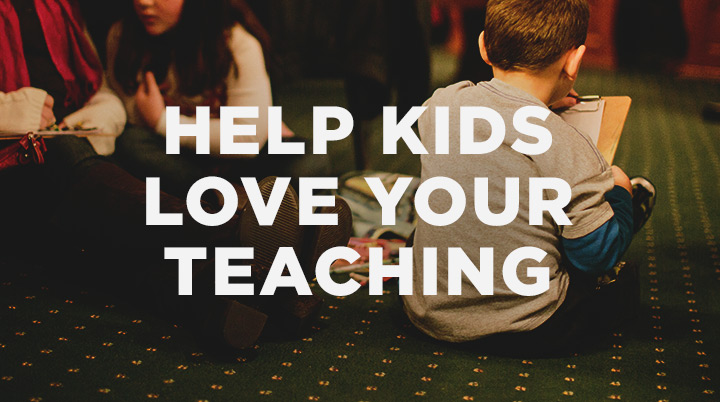Latest
-
Objections to the Christian Faith from the Unchurched and De-Churched
 Tue Dec 02, 2014
Tue Dec 02, 2014
by Resurgence -
Craig Groeschel: We Innovate for Jesus
 Tue Oct 14, 2014
Tue Oct 14, 2014
by Resurgence -
Mark Driscoll: Revelation
 Tue Oct 07, 2014
Tue Oct 07, 2014
by Resurgence -
RESURGENCE LEADERSHIP #034: JOHN PIPER, WHY I TRUST THE SCRIPTURES, PART 2
 Tue Sep 30, 2014
Tue Sep 30, 2014
by Resurgence -
Resurgence Leadership #033: John Piper, Why I Trust the Scriptures, Part 1
 Tue Sep 23, 2014
Tue Sep 23, 2014
by Resurgence

Archives
One Simple Way to Help Kids Love Your Teaching

Because we are made in God’s image, we are drawn to story, and this passion is even more profound with kids. The biggest and best change you can make to the way you teach children is to use story.
The lights glaring in your eyes hide the game-show audience. “Get this next question right,” bellows the show’s host, “and the money’s yours!”
The audience grows quiet. Your palms sweat. “Ten seconds on the clock! Here’s the final question, for the win. Which of these two facilities has a larger annual attendance: Lecture halls, or movie theaters?”
Your hand slams the buzzer before he can finish the word. You just won the easiest game-show question ever. Congratulations!
We are drawn to stories
The question was simple. Comparing the two is laughable. You know that we love movies far more than lectures, because we almost all love stories far more than dry information. Stories compel us—but why?
We are drawn to story because we are made in God’s image (Gen 1:27). God’s primary form of communication is story, because that’s his nature. So it resonates with the nature he has put into us. We were made for it!
Engaging kids through story
What is history? His story.
What is the predominant literary style in the Bible? Narrative.
What was Jesus’ primary teaching style? Parables.
This love for story is even more profound with kids. Have you noticed how much effort it takes to get your kids to come to you so you can tell them information? In contrast, have you noticed how much effort they go to in order to have you come and read them a story, and another story, and another story?
Story resonates with the nature God has put into us. We were made for it!
The biggest and best change you can make to the way you teach children is to use story. This is not simply to entertain them. It’s to engage them. Consider the following factors that are improved when you engage kids through story:
- Better short-term and long-term memory retention
- Greater attention span and desire to remain engaged
- Increased joy in learning
- Wider attraction across the full spectrum of learning styles
- More cognitive connections made around or between concepts
- Higher capacity to reiterate what they heard
Dramatic improvement happens when a teacher shifts from simply telling information and concepts to telling a story. The list could be longer. Add to it the greater joy you will experience in the act of teaching!
“Ok, story, got it. But how?” you ask. Great question. What follows are some basic ideas to get you started in using story.
Teaching through story
Using story goes far beyond simply teaching. Consider the way kids enter your classroom. Are the boys instructed to go to a Lego area? Or are they invited to become expert inventors in a top-secret wacky-Lego-machine-making experiment? Are the girls instructed to go and color? Or are they invited into crayon and paper interior-design collaboration for Sparkelina, Queen of the Bubblegum Forest?
Transitions
If you ever move your group from one spot to another, you can tell kids to walk there. Or, you can use your “amazing imagination wand” to turn them all into jungle explorers with invisible binoculars, searching for the illusive polka-dotted-disco-dancing sloth.
The biggest and best change you can make to the way you teach children is to use story.
Notice how engaged they already are with your leadership before you’ve even gotten to the gold, Scripture. Young Life founder Jim Rayburn famously said, “It’s a sin to bore a kid with the gospel.”
He’s right. Use story to capture kids’ minds, and pray that the Spirit uses it to capture their hearts.
Practical tips
Here are some core pointers for using story in your teaching:
-
Keep the world vivid and the message simple: Kids should be able to see, taste, feel, hear the world you create. But it should all help to focus on one simple idea. Take for instance the story of the paralytic being lowered through the roof (Mark 2:1–12). It’s not just a hole with a guy coming down on a mat. There are unsettling digging noises, people blinded by falling dust and the shock of sunlight, heads peering down from above. Maybe they did the first hole in the wrong spot! But it’s all about one thing—a paralyzed man is about to be lowered down before Jesus.
-
Vary your pitch and pace: Capture minds with silence, explosions of noise, and colorful words. Move your body to be big and small.
-
React to the moment as though you’re in it: For example, don’t just tell of being cold; shiver. They won’t as easily get into the story if you’re not.
Teaching through story does not mean that you only tell story. It means that you use it as the central feature. Once a story is planted in their minds, you can go back and talk about characters, ask questions, and so on.
How can you incorporate story in your teaching?